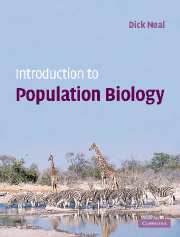Book contents
- Frontmatter
- Contents
- Preface
- Acknowledgements
- PART I Evolution by natural selection
- PART II Simple population growth models and their simulation
- PART III Population genetics and evolution
- PART IV Demography
- Chapter 14 Life tables and age-specific death rates
- Chapter 15 Age-specific reproduction and population growth rates
- Chapter 16 Evolution of life histories
- PART V Interactions between species, and the behaviour of individuals
- Glossary
- Solutions to problems
- References
- Index
Chapter 15 - Age-specific reproduction and population growth rates
- Frontmatter
- Contents
- Preface
- Acknowledgements
- PART I Evolution by natural selection
- PART II Simple population growth models and their simulation
- PART III Population genetics and evolution
- PART IV Demography
- Chapter 14 Life tables and age-specific death rates
- Chapter 15 Age-specific reproduction and population growth rates
- Chapter 16 Evolution of life histories
- PART V Interactions between species, and the behaviour of individuals
- Glossary
- Solutions to problems
- References
- Index
Summary
Conceptually, it is a simple matter to estimate age-specific birth rates. The total number of live offspring produced by samples of females in different age classes is documented, and then the age specific birth rates (Bx) are calculated by dividing the total number of live offspring produced by the sample of females in each age class by the sample size of females in that age class. Thus, if a sample of 30 two-year-old females gave birth to 120 live offspring during the course of the year, the age-specific birth rates of females in age class 2–3 would be 120∕30, or 4.0. In practice, however, it may be difficult to estimate the number of live births. For example, some species of fish lay more than 1,000,000 eggs per female, and it may be extremely difficult to assess what proportion of the eggs are fertilized, i.e. are viable, under natural conditions. Other animals are secretive, and so one cannot observe the number of live births directly. In these cases, a sample of the population may be collected to measure the proportion of the population that is reproductively active in each class and to count the number of eggs, or embryos, or placental scars per female so that age-specific birth rates may be calculated. However, the problem of determining the viability of the offspring at birth still remains.
- Type
- Chapter
- Information
- Introduction to Population Biology , pp. 231 - 244Publisher: Cambridge University PressPrint publication year: 2003



